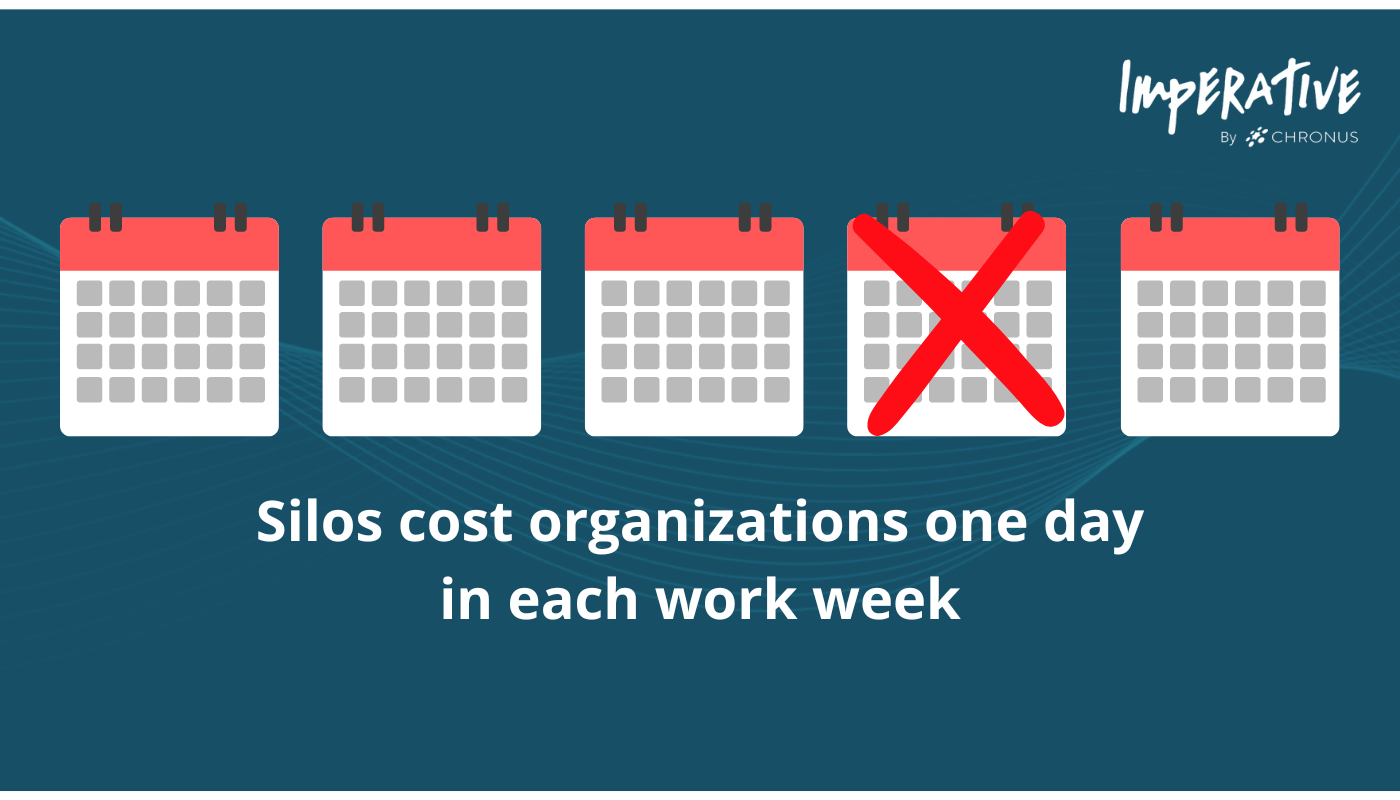In today’s fast-paced business environment, achieving success hinges on the ability to adapt and innovate. One PwC study found 36 percent of companies prioritize a few cross-functional capabilities at the company level and expect functional leaders to identify how they contribute to the mission.
This is always clear when thinking about Sales and Marketing teams. These two pieces of the organization are so critical to telling an engaging story that brings people in and makes them want to buy your solution. If these teams aren’t collaborating and talking to each other, the stories told could look very different for a prospect going from the website to a sales conversation. This disconnect could lead to a poor experience and a missed deal. But by aligning these teams around the same goals and messaging, you can break down silos before they form.
The good news is one study in the Journal of Public Health Management and Practice found 95% of respondents were motivated to reduce silos. This article delves into the strategies and practices that can help your organization collaborate and thrive in a competitive landscape.
Understanding Organizational Silos
Organizational silos can pop up in any company, team, department or function, usually due to limited interaction or communication.
Definition: Organizational silos can be defined as self-contained teams or departments that operate independently, with their own goals, objectives, and communication channels.
These silos typically form due to structural, cultural, and functional divisions. This can lead to a range of problems, including inefficiencies, duplicated work, and a lack of innovation. When departments work in isolation, they may develop their own processes and tools, which can create inconsistencies and hinder the overall performance of the organization. Breaking down organizational silos is essential for fostering a more cohesive and collaborative workplace.
Challenges Silos Present
Silos create significant obstacles in the workplace, including:
- Poor Communication: Departments or teams struggle to share information, leading to misalignment and duplicated efforts.
- Reduced Efficiency: Lack of coordination results in wasted resources, delays, and redundancies.
- Innovation Barriers: Without cross-functional team collaboration, organizations miss out on diverse perspectives and creative problem-solving opportunities.
- Misaligned Goals and Priorities: Without the proper communication channels, teams can be working on projects aimed at different or even incompatible goals, causing people to work in opposite directions of overall business objectives.
- Low Employee Morale: Silos can lead to isolation in teams and departments. This can diminish morale as employees feel less connected to the goals and mission of their teams and responsibilities.
- Customer Experience Issues: For example, fragmented marketing efforts can lead to inconsistent messaging, confusing potential customers, whereas sales teams and customer service teams may not have access to the latest product or service updates, impacting service quality.
These are just a few of the challenges organizational silos present. Addressing these challenges requires strong examples from a unified leadership team, open communication, and tools that promote collaboration across departments.
Types of Silos and Their Impact
Organizational silos can take different forms, each affecting business operations in unique ways. In order to watch out for when and where they might occur, it’s important to know the different types of silos in the workplace.
Departmental Silos
These occur when different departments (e.g., marketing, sales, IT, HR) or different teams operate independently, often prioritizing their own goals over organizational objectives. These silos are often caused by organizational structure, where teams focus solely on their own objectives without integrating with others.
- For example: The IT department implements a new software system without consulting end-users, resulting in low adoption rates.
Departmental silos can lead to:
- Conflicting strategies that hinder company-wide growth
- Inefficient workflows due to a lack of cross-functional communication
Functional Silos
Functional silos arise when teams with the same expertise work in isolation rather than collaborating across the company. These silos arise when functional teams become overly focused on their own best practices and fail to integrate across the organization.
- For example: Finance departments might set budgets without input from operations, leading to resource constraints.
When functional silos become rampant, organizations can experience:
- slower decision making
- misaligned goals
Project-Based Silos
In project-based silos, temporary project teams may become isolated, failing to integrate their learnings and innovations back into the broader organization. These silos are common in companies with multiple short-term projects or large-scale initiatives that lack interdepartmental coordination.
- For example: A product launch team works in isolation, failing to gather input from customer support and sales, leading to gaps in service.
This can cause:
- Knowledge loss once the project concludes
- Redundancies in effort
Organizations need to make regular assessments of their departments to be aware of the risks of these types of silos forming.
Silo Mentality and its Impact on the Entire Organization
Silo mentality can creep up organically or be a part of existing systems in an organization’s culture.
What is Silo Mentality?
Silo mentality is the mindset where teams resist sharing information, resources, or collaboration with other departments. It arises from a focus on self-interest rather than the overall success of the company.
It often stems from things like:
- Competition for recognition or resources
- Fear of losing control over information
- Lack of trust or communication between teams
When teams feel like they are at odds with other parts of the organization, they tend to shut down and isolate their communication or collaboration in an effort to preserve themselves and their team’s objectives.
Consequences of Silo Mentality
Siloed workflows are not just inefficient, they also waste employees’ emotional energy, contributing to the overall energy crisis that we’ve seen in the last several years. PwC estimated that inefficiencies due to silos cost companies 350 hours per year – in other words, one day out of each work week is lost to silos.
- Operational Inefficiencies: Work is duplicated, leading to wasted effort and inconsistencies.
- Lack of Accountability: Departments focus only on their immediate responsibilities, ignoring broader company goals.
- Duplication of Work: When teams do not share knowledge, employees often work on redundant tasks, wasting time and resources.
What Happens When Departmental Silos Form?
When these silos form, they create a disconnect between teams, leading to inefficiencies, poor communication, and reduced team collaboration. Below are the key consequences of departmental silos:
Operational Inefficiencies
Teams work on similar projects without knowledge of each other’s efforts, leading to wasted time and resources. There is often a lack of transparency causes employees to reinvent solutions rather than leveraging existing work.
Inconsistent Processes Across Departments
Each department develops its own way of doing things, leading to inefficiencies and conflicting approaches. Therefore, standardized workflows are difficult to implement, slowing down business operations.
Misalignment of Goals and Strategies
Departments prioritize their objectives over company-wide success, leading to conflicting priorities. In this way, decision-making becomes fragmented, reducing the effectiveness of company strategies.
Poor Communication & Collaboration
Teams can withhold valuable information, either intentionally or due to a lack of communication channels. This means decision-makers struggle to get the insights they need to make informed business choices.
Slow Decision-Making & Delayed Responses
When departments do not communicate, approvals, feedback loops, and problem resolution take longer. When this happens, business agility decreases, making it harder to respond to market changes.
Impact on Employee Morale
Employees can feel disconnected from the broader mission, leading to larger issues in disengagement. As Gallup notes, 76% of employees are already not engaged or actively disengaged in their work. This can lead to a lack of teamwork and reduced job satisfaction as frustration builds due to barriers preventing effective work.
Research supports this, highlighting unmet needs that employees currently feel in their workplace relationships due to disconnection:
- People who help me solve problems and explore new ideas
- People who bring different perspectives
- People who add a sense of purpose to my work
What Causes Organizational Silos?
The Journal of Public Health Management and Practice study also found 58% of respondents identified institutional factors such as the organizational structure and red tape/bureaucracy contribute to siloing. Additional silos form due to a combination of structural, cultural, and operational factors that encourage teams to work in isolation rather than collaboratively. Below are the primary causes of silos in businesses.
Natural Tendency for Specialization
Employees naturally group with colleagues who share similar skills, knowledge, and tasks, leading to silo formation. This tendency is driven by the ease of communication and mutual understanding within specialized groups, as team members feel more comfortable working with those who speak the same technical or professional language.
Structural and Cultural Influences
Organizational silos are often reinforced by structural and cultural factors that shape how employees and teams interact.
- Leadership plays a critical role, as weak interdepartmental leadership leads to isolated decision-making, where teams operate independently rather than as part of a cohesive whole. Without strong executive guidance fostering cross-team collaboration, departments may pursue their own objectives at the expense of the company’s larger vision.
- Incentives also contribute to silos, as performance metrics that focus on individual teams rather than collective company success encourage employees to prioritize departmental goals over broader organizational outcomes. This creates competition for resources, recognition, and promotions, further deepening silos.
- Additionally, Company Culture significantly impacts collaboration; when an organization does not actively promote teamwork and information sharing, employees become accustomed to working in isolation.
Identifying Silos in Your Organization
Leaders and the leadership team as a whole have to be vigilant when spotting silos. This requires a look across the entire organization, and assessing both where silos exist and where there are vulnerabilities for silos to grow.
Signs to Look For
- Interdepartmental conflicts.
- Fragmented communication and inconsistent marketing messages.
- Difficulty accessing necessary information across teams.
Common Symptoms
- Duplication of Work: Teams unknowingly work on similar tasks separately.
- Missed Opportunities: Innovation is stifled due to lack of knowledge sharing.
- Fragmented Communication: Different departments use conflicting tools or platforms, hindering collaboration.
11 Effective Strategies for Removing Silo Mentality
1. Promote a Unified Vision
Leadership must clearly communicate the company’s vision to ensure all departments align with shared organizational goals. A unified vision fosters collaboration by helping employees understand how their work contributes to the company’s broader mission.
2. Enhance Cross-Functional Collaboration
Encouraging joint meetings where team leaders share insights and strategies helps bridge communication gaps between departments. Cross-functional collaboration fosters diverse perspectives, leading to better problem-solving and innovation. By integrating teams with different expertise, organizations can create a more cohesive and adaptable work environment.
3. Implement Collaboration Tools
Using digital platforms such as project management software and collaboration tools enables seamless information sharing across teams. These tools help eliminate knowledge gaps and ensure that employees can access the information they need in real time. When organizations implement the right collaboration technology, teams work more efficiently and transparently.
4. Encourage Interpersonal Relationships
Organize team-building exercises to foster trust and collaboration. Truly eradicating silos starts by creating an intentional plan of connecting the right teams, departments, or groups of employees together. Rob Cross, organizational network analysis expert, has proven through over 20 years of research the value of creating “bridging ties” within your company, compared to the more common and naturally occurring “bonding ties.”
“Strategically leveraging these bridging relationships allows you to see the big picture, generate innovative solutions by integrating the expertise of those with unique backgrounds, bypass bureaucratic gridlock and obtain resources and support.”
Mentoring for distributed teams is a powerful tool to connect people across departments and teams. Leading organizations use mentorship programs because they match peers, providing the development and learning opportunities essential for company growth.
5. Align Departmental Goals with Company Objectives
Each department must understand how its specific goals contribute to overall company success. Aligning objectives ensures that teams do not work in silos but instead coordinate efforts to support a unified strategy. When departmental KPIs are directly tied to business-wide outcomes, teams work together more effectively.
6. Establish Clear Team Goals
Setting and communicating well-defined team objectives helps prevent confusion, conflicts, and inefficiencies. When employees understand their priorities and how they connect with broader company goals, they can work more collaboratively. Clear goals also promote accountability and streamline decision-making across teams.
7. Foster Open Communication
Encourage a culture where employees can share ideas and concerns without fear. Slack conversations or sporadic coffee chats are examples of functional connections between employees, which can help in maintaining relationships but aren’t enough to create the fundamental shift we’re talking about here.
8. Offer Teamwork Incentives
Recognizing and rewarding employees for cross-functional achievements encourages collaboration and discourages siloed thinking. Incentives such as bonuses, awards, or public recognition help reinforce teamwork as a core company value. By celebrating collective success, organizations create an environment where employees actively seek out opportunities to collaborate.
9. Develop a Flexible Organizational Structure
A flexible structure allows employees to move between teams and other departments more easily, fostering adaptability and innovation. When organizations reduce rigid hierarchies, decision-making speeds up, and knowledge flows more freely. Encouraging interdepartmental movement helps employees develop diverse skill sets and strengthens cross-functional relationships.
10. Provide Leadership Training
Equipping managers with the skills to identify and address silo mentality within their teams is crucial to break down organizational silos. Leadership training should focus on collaboration tools and strategies, conflict resolution, and fostering a unified company culture. Strong leadership ensures that cross-team alignment becomes a consistent priority across the organization.
11. Monitor and Adjust Strategies
Regularly assess initiatives to break down silos and adjust as needed. Because organizations are in a near-constant state of change, silos can also continually be created. Having an “always-on” strategy regarding silo-busting is the key way to stay effective.
Intentionally connecting the right employees and creating an environment for them to truly connect are the first two elements. Have employees actively brainstorm or problem-solve together or set team goals for innovative thinking.
Case Study: Intuitive’s Challenges with Silos
The Challenge
Over 12 years, Intuitive grew from 1,500 employees to over 12,000. As they grew, their functional silos grew with them. Intuitive identified 4 key challenges that silos were creating across the organization:
- Lack of connection
- Limited development opportunities
- Limited innovation
As Intuitive increased in size and teams became more specialized, the familiarity that employees once had from visiting with their desk-neighbor began to decrease—employees worked in different buildings, and others across the world, or on different communication platforms.
The Solution
To reduce the challenges brought on by silos, Intuitive’s Director of Global Talent Management, Megan Gage, was looking for a solution that provided development and employee engagement opportunities for employees that was also a low lift on the administrative side, due to tight resourcing.
Gage identified the need for a solution that could scale with the company without requiring a greater input of time and money. With a small L&D (learning and development) team supporting thousands of employees, simplicity and effectiveness were key to success.
The Results
After partnering with Imperative by Chronus, Intuitive has found that participants have created connections, felt supported in their success, and have increased their business acumen.
- 97% percent of people found them helpful or very helpful, within that, 11% described the conversations as “breakthrough.”
- 81% percent completed an action that enhanced their impact or growth at work.
- 90% intend to have an ongoing relationship with their conversation partner.
Intuitive employees formed relationships across functions, the three most common bridging relationships being across business development and operations, communications and operations, and engineering and operations.
Conclusion
By fostering a unified vision, encouraging teamwork, and leveraging technology, businesses can unlock their full potential and drive long-term success. Leaders should assess their organization for silo symptoms and implement strategies to create a more connected and productive workplace.





